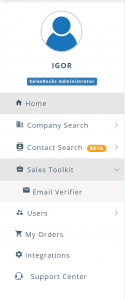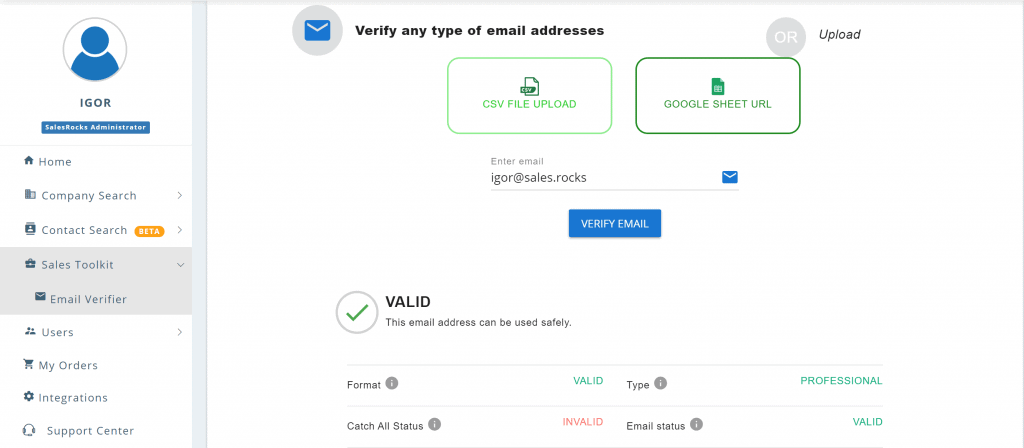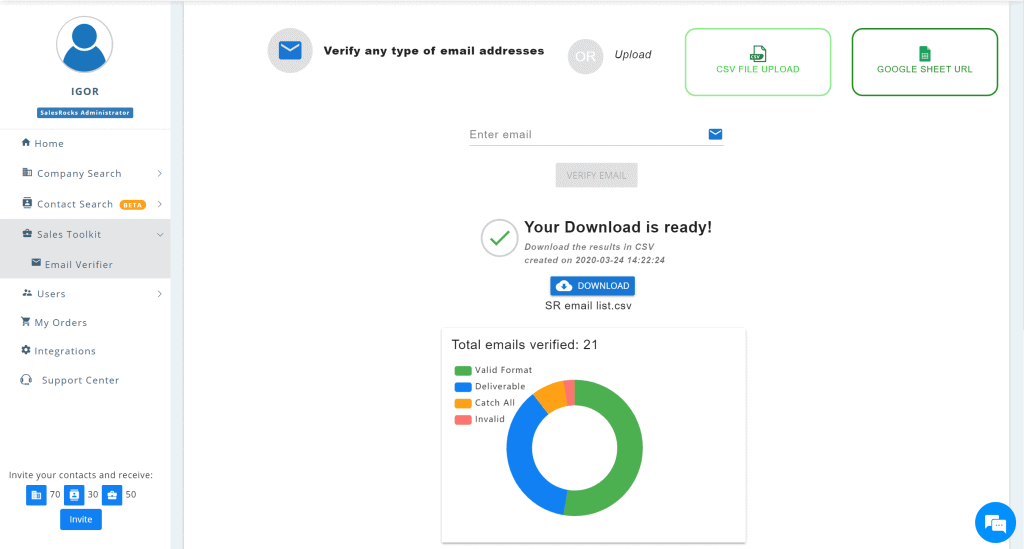Updated on February 16, 2022
Making a lead list for an email outreach campaign is a process that not only consists of finding email addresses. You have to check the emails you have before you start sending them. If you are facing delivery problems, the email address you are trying to contact may be invalid or the company you are reaching out to has set up a catch-all email. Therefore, your bounce rate will be negatively affected. That is where email verification comes into play.
In this article, we will explain what is email verification, how email verification works, why and how you should use it.
What is email verification?
Email verification is the process of verifying the existence of an email address and that is currently in active use. Meaning it can send and receive messages and is tied to a legitimate domain. (There is also a high possibility a person is behind it and will receive your messages 😉 ).
Email validation status represents the status of an email address, valid or invalid.
-
- Valid – the email address is verified and in current use
- Accept-all – the email address is not a catch-all address (messages sent to a nonexistent or mistyped email address on the target domain will be sent to this type of address, but will result in a bounced message)
- Invalid – the email address is not verified and a sent email will result in a bounce
How email verification works
The email verification system depends on the platform. Overall there are several algorithms and overlapping systems checks in place to ensure a better validation model with a higher percentage of accuracy. The Sales.Rocks email verifier uses the following email verification system to provide the most accurate results and ensure optimal email delivery.
There are 7 steps of the email verification process:
-
- Syntax checker
- Gibberish checker
- Domain checker
- Throwaway email checker
- MX record checker
- SMTP Authentication checker
- Accept-all checker
Syntax check
The format of the email address, should contain two parts separated by the at-sign “@”, the local part, and the domain part. It also checks for common syntax mistakes.
“user@sales.rocks”
user – local part
@ – at-sign
sales.rocks domain part
According to internet regulations, an email address must follow these guidelines:
-
- The local part can contain 64 characters at the most
- The ( . ) and the ( @ ) symbol are in the correct place
- Special characters as: ! # $ % & ‘ * + – / = ? ^ _ ` . { | } ~ can be used in the local part
Gibberish check
The email address for random placement of characters indicates online fraud.
Domain check
The domain name is spelled correctly and the domain is valid and currently in use. Also checks whether the email is webmail (Google, Outlook, Yahoo) or a company domain email, indicating a private or a business email address.
Throwaway email check
The domain name belongs to an ESP (email service provider) for temporary email addresses.
Catch-all check
If a dedicated server has a catch-all policy enabled, it will receive all incoming emails. Including gibberish and mistyped emails will result in a bounced message. Catch-all email addresses are set up to avoid unwarranted (mostly spam) emails.
MX record check
If there are MX records on the domain, the email address can receive emails. In other words, checks if the email address is connected to a registered, hosted, and active domain, which is accessible online.
SMTP Authentication (Server ping)
Sending a ping to the email address to see if it can receive and respond to an email message. (One of the best and most reliable methods of email verification)
Why email verification is important
Still not quite sure why you should verify your emails?
Here are four reasons why you should always verify your emails before you start your outreach:
1. Keep your data up to date
Information as with everything else eventually becomes dated and obsolete. People change job positions, companies, domains get shut down and the data you had in your database, becomes effectively worthless. From a data platform perspective, that means bad data and dissatisfied clients.
That is why you need to keep your emails verified if you want to keep your CRM contact data up to date.
2. Email deliverability
With email verification, you can filter invalid emails and reach out only to message those emails that connect you to a potential client. Which also improves your open rate and keeps your bounce rate low.
3. Low bounce rate
Email bounce rate is important. If you are sending emails to an invalid address, that will cost you in the long run by damaging your conversion rate score. It will also result in penalties to your account and will damage your domain reputation.
4. Maintain domain reputation
Low domain reputation is indicative of spam and combined with a high bounce rate and low email deliverability will result in your domain rank/authority. However, by using an email verifier to validate potential email addresses you can save from problems down the line. That is why it is best to think proactively, not retroactively.
The right sales tool for your sales
Sell more with Sales.Rocks
How to choose an email verifier?
There are a lot of available email verification services on the market. Depending on your needs, whether you need a single or bulk email verification or a software or a cloud-based solution.
Software email verifiers are mostly enterprise solutions for a high volume of email addresses with dedicated personnel delegated to the task of managing the lead process.
Offering a one-time payment and a local database with an unlimited number of email verifications for bigger companies may sound tempting. However, the limited hardware access, software compatibility dependency, the need for an additional backup server, and the mandatory updates are surely major drawbacks.
The saas (software as a service) market offerings as Sales.Rocks tackled these issues head. Offering unlimited access, competitive subscription pricing options for small, medium, and large companies, and streamlined ease of use process.
Email verification service
The market offers you a number of email verification tools to choose from. With so many options it is nice to compare different services in several categories. Here is how you can choose your email verification service based on several key points:
1. Freemium
The freemium option gives you a way to test the service capabilities in case you need a few emails verified or if you are building you email list. See which services offer a freemium option or a free trial.
2. Pricing
It is important to offer multiple pricing plans and payment options for individual clients and small and medium companies in addition to large enterprises. Also, you as a client need to get value for your money.
3. Verification method
The exact process of email verification is not the same for every email verification service. Moreover, the details or the number of systems in place for more accurate results are often undisclosed which may spell caution to potential clients. That is why our email verifier uses a 7 point system, so you can be sure that you will get the best results.
4. All in one service hub
Instead of segmenting potential clients based on their needs, our platforms will soon offer a complete Sales Toolkit with an email finder and a Drip Campaign module in addition to the email verifier. Therefore the platform will act as your all-in-one hub for a complete sales service. Why use multiple services when the only one does everything for you?
5. Support
Chatbots and configured preset answers are standard features to help clients use the service. It is also nice to have a customer support agent to contact you in case you have any questions or you need help.
6. Reviews
Before you buy something it is good to know what other users are saying. Reviews are a good way to measure user interest and satisfaction. Additionally, you can also compare competing services on platforms such as G2 and Capterra.
How to verify email addresses
Using the email verifier on the Sales.Rocks platform is easy. Follow this simple guide to quickly verify a single email address or a large number of email addresses in a short time.
First, make an account on the platform to use the email verifier.
The email verifier can be found under the Sales Toolkit tab.

You can type in the email address you wish to verify, upload a CSV file or input a google sheet URL.
On the email validation screen, you will see the status of your verified email in 4 categories.

-
- Format – checks whether the email is in the correct format
- Type – checks whether the email is private or business-related
- Catch-All status – checks whether an email is Catch-All email type
- Email status – checks whether the email is deliverable
If you are verifying a large number of emails addressed the results will also be color-coded in 4 categories. Green means that the email is valid, blue indicates that the emails are deliverable, orange signifies their catch-all status and emails marked red are invalid.

After you are done verifying your email addresses they will be saved under your profile. You can also export your email lists into a CSV file.
Why Sales.Rocks email verifier?
This guide shows you why email verification is important and how it can benefit your email reach out. Thanks to our 7 step email verification process you can be sure of a high email delivery rate and a low bounce rate.
Still, have questions we haven’t answered in the article?
Drop us an email and check out our knowledge base for more information about the platform.
Learn how to drive more sales


